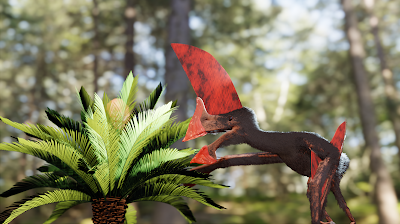 |
| Tupandactylus navigans (Frey, Martill & Buchy, 2003) in Beccari, Pinheiro, ...et Costa, 2021. |
Abstract
A remarkably well-preserved, almost complete and articulated new specimen (GP/2E 9266) of Tupandactylus navigans is here described for the Early Cretaceous Crato Formation of Brazil. The new specimen comprises an almost complete skeleton, preserving both the skull and post-cranium, associated with remarkable preservation of soft tissues, which makes it the most complete tapejarid known thus far. CT-Scanning was performed to allow the assessment of bones still covered by sediment. The specimen can be assigned to Tupa. navigans due to its vertical supra-premaxillary bony process and short and rounded parietal crest. It also bears the largest dentary crest among tapejarine pterosaurs and a notarium, which is absent in other representatives of the clade. The new specimen is here regarded as an adult individual. This is the first time that postcranial remains of Tupa. navigans are described, being also an unprecedented record of an articulated tapejarid skeleton from the Araripe Basin.
Systematic palaeontology
Pterosauria Kaup, 1834
Pterodactyloidea Plieninger, 1901
Tapejaridae Kellner, 1989
Tapejarinae Kellner & Campos, 2007
Tupandactylus Kellner & Campos, 2007
Tupandactylus navigans (Frey, Martill & Buchy, 2003)
Material. GP/2E 9266, an almost complete skeleton with associated soft tissue remains
Horizon and locality: Crato Formation, Santana Group, Araripe Basin, NE-Brazil. Early Cretaceous (Albian). Exact locality undetermined.
Revised diagnosis.
Tupandactylus navigans can be distinguished from other tapejarid pterosaurs by 1) previously defined autapomorphies: premaxillomaxilla concave anteriorly; a striated premaxillary crest; supra-premaxillary bony process perpendicular to the long axis of the skull; parietal crest short and rounded; 2) autapomorphies identified in GP/2E 9266: anteriorly deflected expansion of premaxillary crest; deep and blade-shaped dentary crest with subvertical posterior margin; lateral surfaces of cervical vertebrae postzygapophyses with longitudinal grooves.
 |
| Fig 16. Skeletal mount of Tupandactylus navigans specimen GP/2E 9266. Skeletal mount of all bony elements recovered with the image segmentation of specimen GP/2E 9266. Scale bar = 50 mm. |
 |
| Skeletal reconstruction of Tupandactylus navigans based on specimen GP/2E 9266 in lateral (A) and dorsal (B) views. Scale bar = 50 mm. |
Victor Beccari, Felipe Lima Pinheiro, Ivan Nunes, Luiz Eduardo Anelli, Octávio Mateus and Fabiana Rodrigues Costa. 2021. Osteology of An Exceptionally Well-preserved Tapejarid Skeleton from Brazil: Revealing the Anatomy of A Curious Pterodactyloid Clade. PLoS ONE. 16(8): e0254789. DOI: 10.1371/journal.pone.0254789






